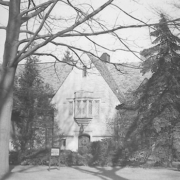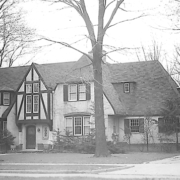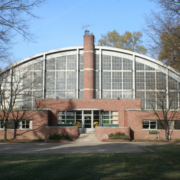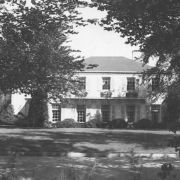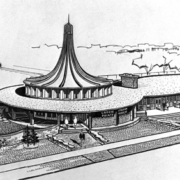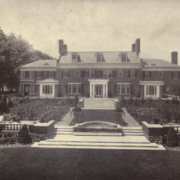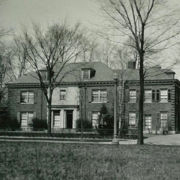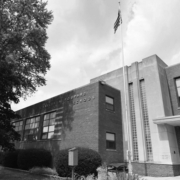Historical Architecture of Grosse Pointe – 40 Oxford Road
Last week we presented the history of the area known as Fox Creek. Situated close to Windmill Pointe the creek has an important and historic past, not only as an integral waterway but also as the home to an historic marker commemorating the Fox Indian Massacre.
This week we head to 40 Oxford Road. Completed in 1934, this stunning property was designed by Detroit based architects Herman & Simons for Charles F. Becker.
We first explored this home in 2022. However, we were recently contacted by Doug Milligan, who asked if we could make a few updates to the post. Well, we were happy to do that, and Doug kindly sent us some interesting details to add to the post – the article shares some of the fond memories Doug has about the home. The info from Doug is published with his permission and has been edited by Katie Doelle. Image courtesy of Michigan Architect and Engineer (1936).
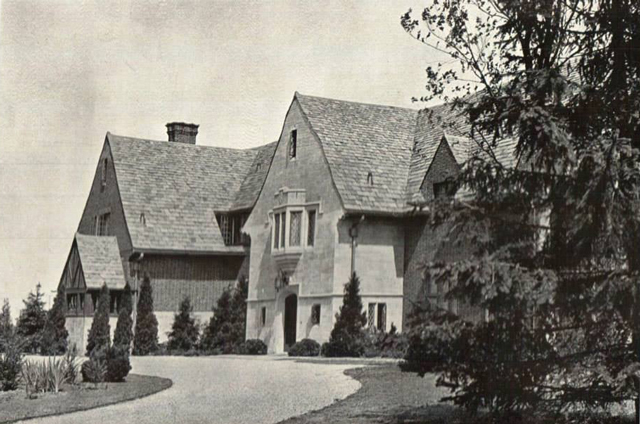
40 Oxford could be described as one of the “grande dames” that exist on the first block of this prestigious street. The 7,796 sq ft brick-built property is an imposing brick built English Tudor that was once located on three lots. The exterior of the home is dominated by the magnificent three-story high limestone clad gable that is the location of the main entranceway and an oriel window, supported by a corbel, above the front door. As one would expect, the interior is filled with superb architecture details including beautiful wood paneling throughout, intricate carved woodwork, a sunken living room, and four large natural fireplaces.
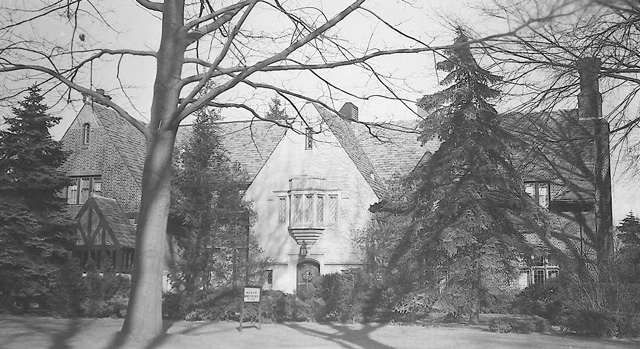
Doug recalls…
The wooden 5” thick front door opened to the impressive foyer (18’ x 16’ sq ft) that had a slate floor. When you entered the hallway, on the right were eight-foot-wide stairs that led up to a balcony which overlooked the greeting room and into the library (24’ x 15’ sq ft). The next set of stairs led to another balcony that overlooked the entire living room – what an entrance a lady could make! From the hallway you could step up into the greeting room and access a large walk-in closet. Further on was a very nice powder room, along with the entrance to the kitchen and the opening to the formal dining room. There was the option to close off the openings to the closet, powder room, and the hallway with doors that blended in perfectly with the rest of the picture framed walls – you would never know the rooms were there.
The hallway also provided an entrance to the library which had a fireplace and a bow window that overlooked the garden. On the east wall was the entrance to the sunken living room (20’ x 30’ sq ft) that had a fireplace at the far end. Large windows overlooked the terrace which was tiled with slate and had an awning that could be rolled up when the weather was nice. Also on the main floor was the dining room (16’ x 18” sq ft) that lead to the breakfast room which then connected to the butler’s pantry. Doug recalls, there was a little step switch in the breakfast room (to alert the maid) – it would light up a panel in both the kitchen and the butler’s pantry. Doug explains, one unique thing in the butler’s pantry and the kitchen was the refrigerator – it was the same style as the appliance in the Edsel Ford house only it had doors on both sides. Doug remembers how his dad tried to fix it once and had to call the fire department to air out the house after he had opened one of the cooling lines and let the gas out.
The large kitchen had nickel counter tops and a ceramic tiled floor. From the kitchen, towards the front of house was a short hall that led to a small office, the service entrance, and stairs to the servants’ quarters. Meanwhile, in the basement was a large room for laundry, a work room, a mechanical room, a room with a stage, plus a space with a low ceiling that was situated under the living room. On the second floor, the master bedroom was as big as the living room (20’ x 30’ sq ft) with a fireplace and a 7’ x 10’ bay window. There were an additional three main bedrooms, along with two further bedrooms for maids.
The property also had a heated three car garage (with running water), and on the right of the house was the greenhouse that had everything a gardener would want – nice areas to grow plants, and heat. Doug fondly remembers his mom telling him about the owner’s grandson and his friend throwing stones at the windows of the greenhouse. The garden was huge, with a tennis court located on the lot to the left of the home. When Philip Baker owned the house (1957 – 1976) the property overlapped his daughter’s yard on Renaud, which meant his grand kids could come and visit by running through the connecting gardens. Doug shared that Mr. Baker’s son-in-law (on Renaud) didn’t like that the landscape company dumped their clippings on the vacant lot next to his house, so he bought it and landscaped it. Problem solved!
The original owner of the property was Charles Frederick Becker. He was born in Detroit on 12 August 1880, and married Laura Lau in April 1906. He was the owner of the Charles F. Becker Wholesale Cigar Company and was one of the founders of the Grosse Pointe Yacht Club – he was on the board of directors in 1929. At the time of his death on 2 December 1947, it appears Mr. Becker had sold 40 Oxford and was living at 1244 Three Mile Dr, Grosse Pointe Park. 40 Oxford had been purchased by Herbert J. Woodall, a prominent industrialist in Detroit, and owner of Woodall Industries. In 1956, Mr. Woodall listed the property for sale for $100,000 (around $1.1 million today) – our files indicate Mr. Woodall was willing to split the lots and sell the area with the tennis court separately. 40 Oxford was then purchased by Philip C. Baker (Doug’s moms’ boss) on 11/20/57 for $70,000 (around $783,000 today). Mr. Baker would live at the property until March 1976. The lot (with the tennis court) was ultimately purchased by the house next door (on the left of 40 Oxford).
Doug recalls, before Mr. Baker moved in his dad was looking around and was in the basement and noticed a valve was labeled sprinklers. He turned it on and all of them came on front and back. Then a short time later the water department arrived because all the other homes in the area had lost water pressure. The line was a 4-inch line, they told him not to ever turn it on again!
Below is an overhead view of the property as it was in 2002 and how it appears today. 46 Oxford, built on the lot that was once the location of the tennis court (to the west of 40 Oxford), was constructed in 2003. Images courtesy of Google Earth.
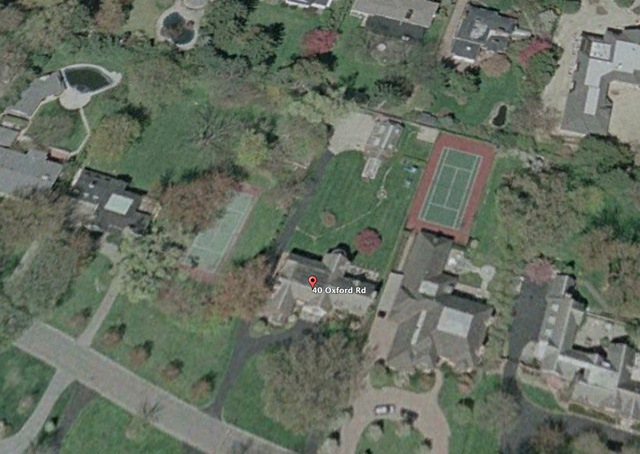
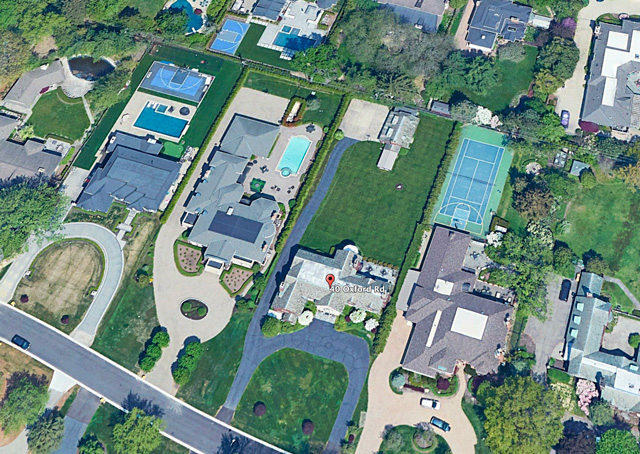
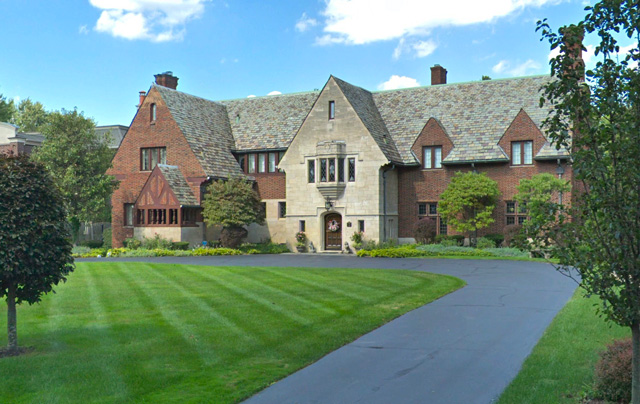
The architects of 40 Oxford were Aloys Frank Herman and Howard Thomas Simons. Their firm, Herman & Simons, were involved with the design of churches, banks, and schools in southeastern Michigan. We understand they designed multiple homes in Indian Village. They also created multiple homes throughout the Grosse Pointe communities between the early 1920’s through to the mid 1930’s. Many of these homes are grand affairs, including:
- 1041 Lochmoor – 1923
- 405 Lakeland – 1923
- 819 Edgemont – 1925
- 1023 Bishop – 1927
40 Oxford is one of the few remaining historic mansions on Oxford Road. A big thank you to Doug Milligan for taking the time to share his memories of this stunning home.
*Photos courtesy of the Higbie Maxon Agney archives unless stated.
** Research, information, and data sources are deemed reliable, but accuracy cannot be fully guaranteed.
Written by Katie Doelle
Copyright © 2024 Katie Doelle

